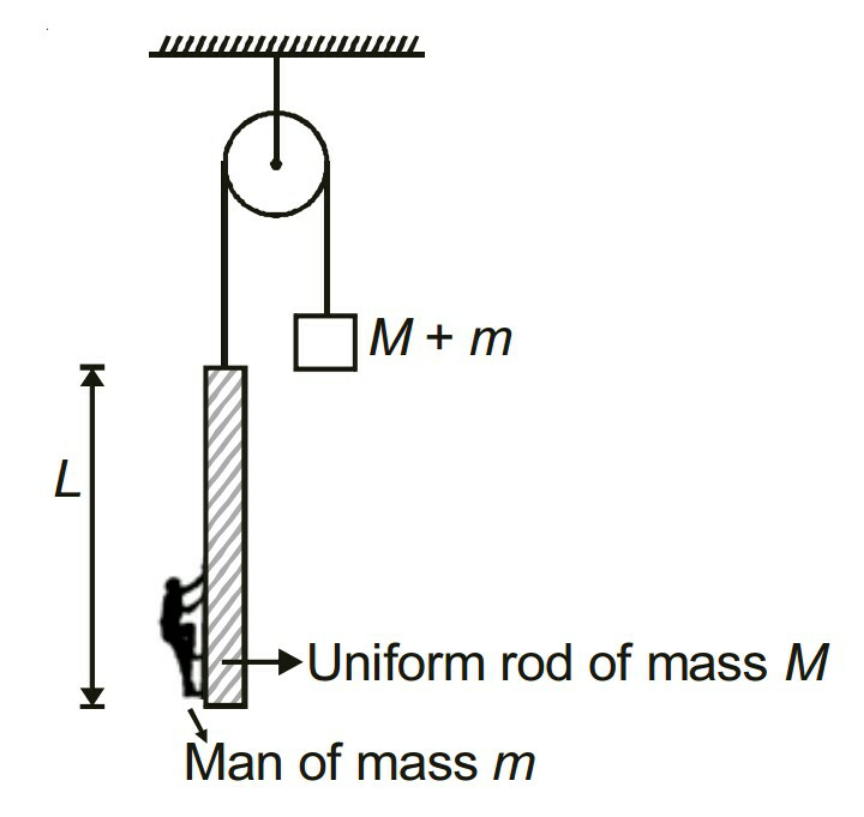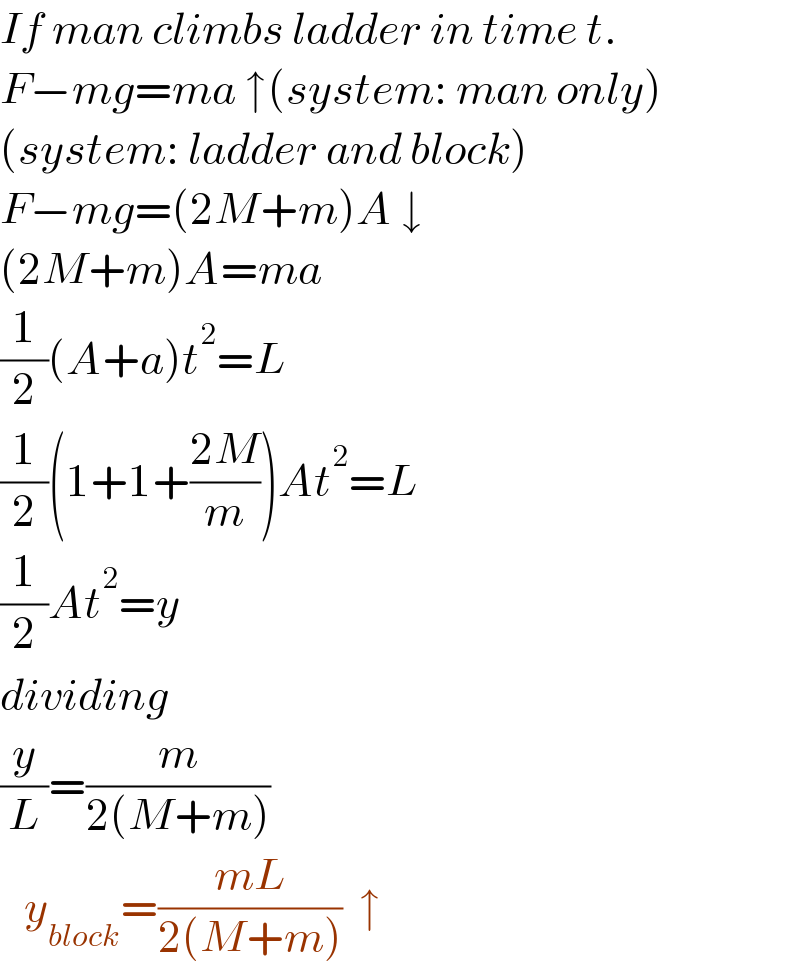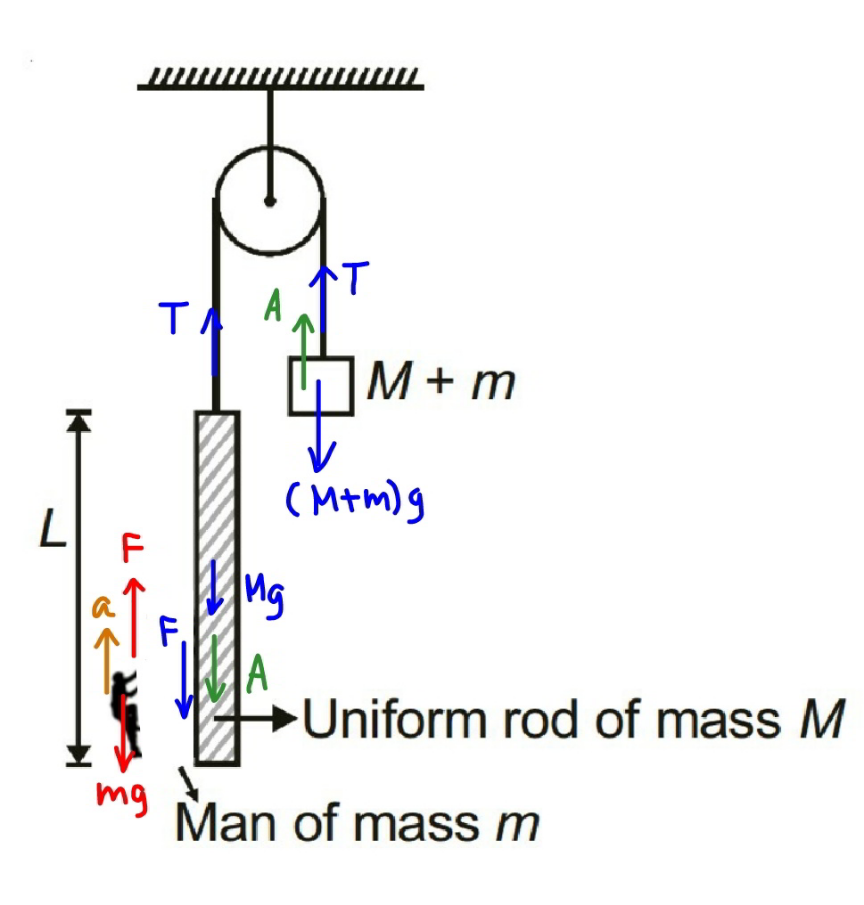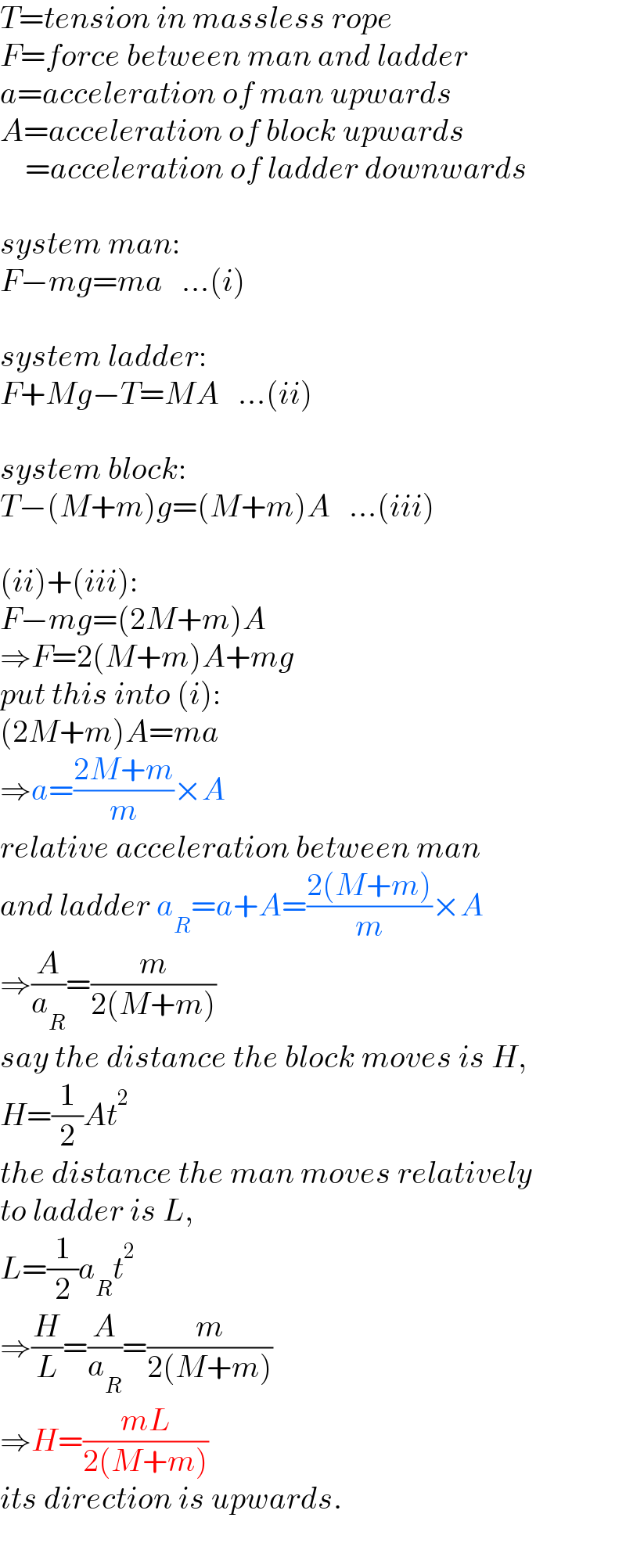Question Number 129542 by mr W last updated on 16/Jan/21

Commented by mr W last updated on 16/Jan/21

$${when}\:{the}\:{man}\:{climbs}\:{the}\:{ladder}\:{from} \\ $$$${bottom}\:{to}\:{top},\:{how}\:{much}\:{does}\:{the} \\ $$$${block}\:{move}\:{and}\:{in}\:{which}\:{direction}? \\ $$
Answered by ajfour last updated on 17/Jan/21

$${If}\:{man}\:{climbs}\:{ladder}\:{in}\:{time}\:{t}. \\ $$$${F}−{mg}={ma}\:\uparrow\left({system}:\:{man}\:{only}\right) \\ $$$$\left({system}:\:{ladder}\:{and}\:{block}\right) \\ $$$${F}−{mg}=\left(\mathrm{2}{M}+{m}\right){A}\:\downarrow\: \\ $$$$\left(\mathrm{2}{M}+{m}\right){A}={ma} \\ $$$$\frac{\mathrm{1}}{\mathrm{2}}\left({A}+{a}\right){t}^{\mathrm{2}} ={L} \\ $$$$\frac{\mathrm{1}}{\mathrm{2}}\left(\mathrm{1}+\mathrm{1}+\frac{\mathrm{2}{M}}{{m}}\right){At}^{\mathrm{2}} ={L} \\ $$$$\frac{\mathrm{1}}{\mathrm{2}}{At}^{\mathrm{2}} ={y} \\ $$$${dividing} \\ $$$$\frac{{y}}{{L}}=\frac{{m}}{\mathrm{2}\left({M}+{m}\right)} \\ $$$$\:\:\:{y}_{{block}} =\frac{{mL}}{\mathrm{2}\left({M}+{m}\right)}\:\:\uparrow \\ $$
Commented by mr W last updated on 16/Jan/21

$${great}!\:{thanks}! \\ $$
Commented by Emptyset last updated on 17/Jan/21

$${can}\:{you}\:{please}\:{elaborate} \\ $$
Answered by mr W last updated on 17/Jan/21

Commented by mr W last updated on 17/Jan/21

$${T}={tension}\:{in}\:{massless}\:{rope} \\ $$$${F}={force}\:{between}\:{man}\:{and}\:{ladder} \\ $$$${a}={acceleration}\:{of}\:{man}\:{upwards} \\ $$$${A}={acceleration}\:{of}\:{block}\:{upwards} \\ $$$$\:\:\:\:={acceleration}\:{of}\:{ladder}\:{downwards} \\ $$$$ \\ $$$${system}\:{man}: \\ $$$${F}−{mg}={ma}\:\:\:…\left({i}\right) \\ $$$$ \\ $$$${system}\:{ladder}: \\ $$$${F}+{Mg}−{T}={MA}\:\:\:…\left({ii}\right) \\ $$$$ \\ $$$${system}\:{block}: \\ $$$${T}−\left({M}+{m}\right){g}=\left({M}+{m}\right){A}\:\:\:…\left({iii}\right) \\ $$$$ \\ $$$$\left({ii}\right)+\left({iii}\right): \\ $$$${F}−{mg}=\left(\mathrm{2}{M}+{m}\right){A} \\ $$$$\Rightarrow{F}=\mathrm{2}\left({M}+{m}\right){A}+{mg} \\ $$$${put}\:{this}\:{into}\:\left({i}\right): \\ $$$$\left(\mathrm{2}{M}+{m}\right){A}={ma} \\ $$$$\Rightarrow{a}=\frac{\mathrm{2}{M}+{m}}{{m}}×{A} \\ $$$${relative}\:{acceleration}\:{between}\:{man}\: \\ $$$${and}\:{ladder}\:{a}_{{R}} ={a}+{A}=\frac{\mathrm{2}\left({M}+{m}\right)}{{m}}×{A} \\ $$$$\Rightarrow\frac{{A}}{{a}_{{R}} }=\frac{{m}}{\mathrm{2}\left({M}+{m}\right)} \\ $$$${say}\:{the}\:{distance}\:{the}\:{block}\:{moves}\:{is}\:{H}, \\ $$$${H}=\frac{\mathrm{1}}{\mathrm{2}}{At}^{\mathrm{2}} \\ $$$${the}\:{distance}\:{the}\:{man}\:{moves}\:{relatively} \\ $$$${to}\:{ladder}\:{is}\:{L}, \\ $$$${L}=\frac{\mathrm{1}}{\mathrm{2}}{a}_{{R}} {t}^{\mathrm{2}} \\ $$$$\Rightarrow\frac{{H}}{{L}}=\frac{{A}}{{a}_{{R}} }=\frac{{m}}{\mathrm{2}\left({M}+{m}\right)} \\ $$$$\Rightarrow{H}=\frac{{mL}}{\mathrm{2}\left({M}+{m}\right)} \\ $$$${its}\:{direction}\:{is}\:{upwards}. \\ $$
